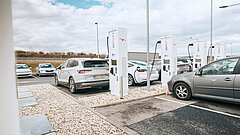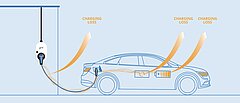EV Charging Efficiency: Why Are There Energy Losses and How to Avoid Them?
Last updated:
If your vehicle’s battery capacity is 58 kWh, it doesn’t mean you can charge it from zero to full, spending exactly 58 kWh on that. Surprise… You often need to charge more power than the car actually receives. And consequently, you need to pay more.
According to the ADAC, you can lose between 10 and 25% of the total amount of energy charged.
Quite a number, huh?
And the thing is, you normally cannot avoid it - the energy simply gets lost on the way to your vehicle.
But why is that? And what can you do to minimise energy loss when charging the battery? Let’s see!
Do you want to allow Integration of youtube videos?
Allows the playback of videos, that are hosted on youtube.com. By allowing this feature, you accept the privacy agreement of google.
What is EV Charging Loss?
Whenever energy moves from point A to point B or gets converted from one form into another, there are always some charging losses. This happens when you charge your car, tablet, phone or anything else with a battery inside it.
Whether or not you are into physics, you probably know the law of conservation of energy: Energy cannot be created or destroyed, it can only be changed from one form to another.
For instance, when you run, your energy is converted into the heat coming from your body. This is the same with charging electric cars.
Energy does not disappear but… where does it go? We’ll show you.
4 Main Factors Affecting EV Charging Efficiency
The charging process with an AC charger involves several components:
-
On-board charger
-
Charging cable
-
Charging power
-
EV battery
Each of them takes part in causing the power loss and decreasing charge efficiency.
Factor 1: EV charging loss due to the on-board charger
Sadly, the on-board chargers are the ones to blame the most when it comes to energy loss as they are usually between 75 and 95 percent efficient.
Let’s see why.
The main function of the on-board charging system is to convert AC power into DC.
The conversion produces heat, which is why the power electronics in an EV are normally liquid-cooled. Nevertheless, it does not protect you from power loss completely… unfortunately.
The on-board charging systems work particularly inefficiently when too little current is flowing. However, there is basically nothing you can do to prevent the charging loss at this stage of the process.
Note: Although charging at high speed seems like a solution, doing it all the time is harmful to the environment. The fact is that high currents increase the pressure on the electricity grid, while lower currents make a valuable contribution to the stability of the grid.
Factor 2: EV charging loss due to the charging cable
Some energy is getting lost while running through the charging cable.
This is a matter of resistance. The shorter the charging cable is, the lower the power loss.
Why? Because the resistance is lower.
Our tip: Try to choose a cable with an optimal length for charging your vehicle.
Factor 3: EV charging loss due to the charging power
Higher power generates higher heat. And as you already know, heat is what the energy normally turns into.
A thick charging cable is one of the things that can reduce the heat and, therefore, prevent energy loss. The higher the charging speed, the thicker the cable should be.
Suppose you charge your electric car at 11 kW and 22 kW with the same cable intended for an 11 kW charging station.
What will happen?
With 22 kW, the losses will be higher as more heat is generated. It is therefore better to have a cable designed for a particular charging speed or even exceeding it, as in this case the energy loss will be lower.
Our tip: You need a thick cable for charging. For instance, go-e offers suitable cables for charging at up to 22 kW which allows to minimise the energy losses significantly.
Factor 4: Charging loss due to the electric car battery
Electrical energy from the charging station is converted into chemical energy in the lithium-ion battery. The conversion process causes heat and as a result power losses.
Luckily, most electric car battery packs, Nissan LEAF aside, come with a thermal management system to reduce energy loss when the battery is heating up or cooling down.
Our tip: The lower the charging capacity, the “softer” the conversion and the lower the losses. Therefore, charging your electric car at lower speed is financially beneficial. In addition, lower currents make a valuable contribution to the stability of the electricity grid.
Additional Factors for EV Charging Losses
If you are charging your vehicle on a winter day when it’s freezing, you will notice that the process is slower than usual.
The thing is the EV battery needs to warm up before it starts charging. The process requires some energy that would otherwise go directly into the battery.
On the other hand, boiling summer days are not ideal for EV charging either.
Luckily, most electric vehicles have a cooling circuit to reduce the temperature of the battery when charging in hot weather.
These are not exactly power losses but rather way of additional power consumption. According to some experiments, the ideal temperature for EV charging and operating is 20-25°C.
Our tip: Warming up your battery before charging might be a good idea. If your electric vehicle has battery preconditioning, we suggest you bring your battery to room temperature prior to charging.
Note: Charging the car as soon as you arrive while the battery is still warm may seem like the perfect option. However, if many people start charging the battery immediately after returning home from work, the power grid will suffer from the great pressure.
When it comes to charging in hot weather, our advice is, well, pretty obvious: try to park your vehicle in the shade to avoid overheating its battery.


Ronald Kroke - Head of Marketing at go-eCharging losses lead to a discrepancy between the electricity meter and the display in the car
Some customers notice that their go-e Charger Gemini shows more kWh charged than their car actually received. This often raises concerns about the meter's accuracy, especially since it isn’t certified. But here we can reassure you that even with a certified MID-compliant meter in the wallbox, as with the go-e Charger PRO, there will be a similar deviation between the electricity meter of the wallbox and the display in the electric car due to the physically induced charging losses. Tests like those from ADAC help raise awareness about these losses, and following a few tips can help minimise them.
How Can You Measure the EV Charging Loss?
The most obvious way to do it would be to charge your car battery from zero to 100% and check how much power was consumed. After that, you could compare this figure with your car battery capacity and voilà - the difference is the charging loss. But don’t rush to do it as such an experiment might cost you an arm and a leg. There is nothing good about discharging a car battery to a bare minimum!
But how can you find out what charging loss you experience every time you plug in the charging cable into your vehicle?
You can use the data provided by reputable testing organizations.
For instance, ADAC has conducted an ecotest using the same 22 kW wallbox (AC) and the same ambient conditions (23°C) to discover the charging loss. The charging losses turned out to be considerable.
For instance, the result shows that 125.2 kWh must be charged to fill the 105 kWh battery of the BMW iX. The situation is no better in the case of the less expensive Jaguar i-Pace - 100.8 to 90 kWh.
AC vs. DC Charging: Difference in the EV Charging Loss
As we mentioned before, charging loss mostly happens while AC power is converted into DC by an on-board charger. This is relevant for AC charging.
But how about DC charging? If energy does not need to be converted once it’s out of the charging station, is the energy loss significantly lower?
Basically, it’s true. Bear in mind, though, that charging with direct current is not ideal either. As more current flows in a shorter time, it causes heat losses. However, these are just minor losses and DC charging is more efficient in any case.

Note: Constantly charging your electric car from DC chargers may be harmful to your vehicle’s battery. They are more suitable for situations where you need to charge your EV very quickly. When you have more time to fill your car battery with power, AC charging stations such as the go-e Charger are a much better choice.
Summary
None wants to pay a pretty penny for energy that goes nowhere. No wonder the topic of charging losses is getting increasingly important.
The German automobile club called ADAC even made a requirement for EV manufacturers to include charging losses to the general technical information.
One thing you need to remember is that nothing in the world is 100% efficient.
Even though the charging losses story sounds pretty horrifying, it’s nothing compared to the losses when burning petrol in an internal combustion engine to drive a car!

